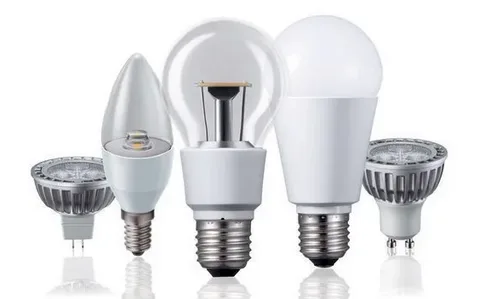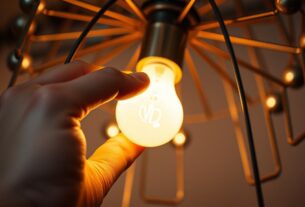It is very important to have good lighting in both homes and businesses. There are a lot of things to think about when picking between LED light bulbs and standard incandescent or CFL bulbs, such as how much they cost, how long they last, and how well they work overall. Knowing the main distinctions can help you choose according to your needs.
1. Energy Efficiency: Which One Saves More?
LED light bulbs offer among their main benefits their efficiency. Conventional incandescent bulbs waste a lot of energy since a lot of electricity they convert into heat. LEDs, on the other hand, consume most of their energy, creating light rather than heat.
For example, the brightness of a 10-watt LED light bulb can be equivalent to a 60-watt incandescent bulb. This implies that, using much less electricity, you can produce the same illumination output, which over time will help to cut energy expenditures.
2. Lifespan: How Long Do They Last?
Another area in which LED light bulbs shine above conventional choices is longevity. Whereas CFLs can last up to 8,000 hours, incandescent bulbs usually only last 1,000 hours. LEDs are a reasonably cheap choice over time, though, since they may run 25,000 to 50,000 hours.
3. Heat Emission and Safety
Particularly in enclosed fixtures or adjacent to flammable materials, the considerable heat emitted by incandescent bulbs might be a safety issue. Though far less than incandescent lamps, CFLs also create some heat.
Conversely, LED lights stay cool to the touch even after several hours of operation. In interior settings, this lowers the risk of burns, fire hazards, and too strong heat accumulation.
4. Initial Cost vs. Long-Term Savings
One often-used critique of LED light bulbs is their starting cost. Up front, a single LED bulb could be more expensive than an incandescent or CFL. Still, the initial outlay is less than the long-term savings in replacement prices and electricity bills.
For example, replacing a single 60-watt incandescent bulb with a 10-watt LED light bulb can save up to $100 over the lifespan of the LED. If you multiply this savings across multiple bulbs in a home or office, the financial benefits become evident.
5. Light Quality and Brightness
Both LED and traditional bulbs provide adequate lighting, but the quality of light differs. Incandescent bulbs emit a warm, natural glow that many people find pleasing. CFLs offer a range of color temperatures but can sometimes flicker or take time to warm up.
Conversely, LEDs span a range of color temperatures, from warm white to daylight. They also offer constant brightness free of flickering or warm-up time required. Furthermore, dimmable LED choices let one better regulate ambiance, something not always achievable with CFLs.
6. Environmental Impact
Sustainability is a major concern for many consumers. Traditional incandescent bulbs contribute to significant waste because of their short lifespan and high energy consumption. CFLs contain small amounts of mercury, requiring special disposal methods to prevent environmental contamination.
LEDs are the most eco-friendly option, as they use less energy, last longer, and do not contain toxic elements. Choosing 300 watt LED light bulbs can significantly reduce carbon footprints, making them a responsible choice for sustainability-conscious consumers.
7. Compatibility with Fixtures
Before switching to LEDs, it’s essential to check compatibility with existing fixtures. Incandescent and CFL bulbs work with most traditional fixtures without modification. LEDs, however, sometimes require specific drivers or transformers, particularly in recessed lighting or dimmable settings.
While most modern LED bulbs are designed to fit standard sockets, older homes with outdated wiring may need slight adjustments. Checking compatibility before purchasing ensures seamless integration.
8. Performance in Extreme Conditions
If you need lighting for outdoor use or harsh environments, LEDs offer better durability. Traditional bulbs can struggle in extreme temperatures, often burning out faster in cold or humid conditions.
Outdoor security lights, industrial facilities, and refrigeration equipment benefit from 300 watt LED light bulbs wide temperature range and vibration and shock resistance.
9. Color Rendering Index (CRI)
Color accuracy is crucial in settings like photography studios, art galleries, and retail spaces. The Color Rendering Index (CRI) measures how accurately a light source displays colors compared to natural sunlight.
Incandescent bulbs generally have a high CRI, making colors appear rich and vibrant. CFLs have varying CRI ratings, often making colors appear washed out. LEDs, particularly high-quality ones, have excellent CRI ratings, ensuring true-to-life color representation.
10. Smart Lighting Integration
With the rise of smart homes, LED bulbs have an edge over traditional lighting. Smart LED bulbs can be controlled via mobile apps, voice assistants, or automation systems, allowing users to adjust brightness, set schedules, and change colors with ease.
Incandescent and CFL bulbs lack this level of customization unless paired with external dimmers or controls, which can add to overall costs. 300 watt LED light bulbs often come with smart features for enhanced user control.
11. Impact on Eye Health
Harsh lighting can cause eye strain, headaches, and discomfort, especially for those who spend long hours under artificial light. Incandescent bulbs emit a natural, warm glow that is easy on the eyes. CFLs, however, often flicker, causing visual discomfort.
LEDs provide consistent and flicker-free lighting. Many models come with blue-light reduction features, reducing eye strain for people working on screens or reading for extended periods.
12. Availability and Future Trends
While incandescent bulbs are becoming less common due to energy regulations, CFLs and LEDs are widely available. However, LED technology is advancing rapidly, with improved efficiency, longer lifespans, and better light quality.
Future innovations include tunable white lighting, better dimming capabilities, and even self-adjusting lights that adapt to natural daylight changes. These advancements make LEDs a forward-thinking investment compared to traditional options.
13. Government Regulations and Incentives
Many countries are phasing out incandescent bulbs due to energy inefficiency. Government incentives and rebates often encourage the use of LED lighting by offering discounts or tax benefits.
Switching to LEDs not only helps comply with regulations but also takes advantage of potential financial incentives, making the transition even more cost-effective.
14. Specialized Applications
Certain applications require specific types of lighting. Incandescent bulbs are still used for decorative purposes, such as chandeliers and vintage-style fixtures. CFLs are commonly found in offices and commercial spaces.
300 watt LED light bulbs are now widely used in everything from automotive headlights and industrial warehouses to aquariums and horticultural lighting. Their versatility and adaptability make them suitable for almost any lighting need.
Final Verdict: Which One is Right for You?
The decision between LED light bulbs and traditional options depends on your priorities. If affordability and familiarity are key, incandescent bulbs might still be an option for short-term use. If energy savings, longevity, and environmental impact matter, LEDs are the clear winner.
With advances in LED technology, there’s little reason to stick with older lighting solutions. 300 watt LED light bulbs are the best option for most uses since their long-term advantages exceed their initial cost.
By considering factors like energy efficiency, lifespan, light quality, and safety, you can confidently choose the right lighting solution for your home or business. Making the switch to 300 watt LED light bulbs ensures a brighter future—both financially and environmentally.
To read more similar stories, click here.




